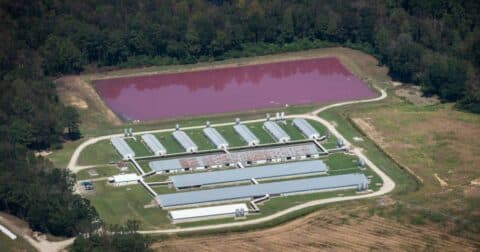News
Could Genetically Engineered Fungus Help Replace Animal Protein?
Breakthroughs•5 min read
Reported
A new study uses satellite data to document environmental inequities in North Carolina.


Words by Sara Hashemi
Air pollution linked to industrial hog farms in eastern North Carolina can be seen from space, according to a new study from researchers at the University of Virginia. The findings confirm concerns from communities in Duplin and Sampson counties in North Carolina over air quality, and challenge the North Carolina Department of Environmental Quality’s claims that there is limited exposure to ammonia from these farms.
Sally Pusede, an atmospheric chemist and lead author of the study, used satellite data spanning from 2008 to 2023 to analyze the levels of ammonia in the atmosphere and mapped it onto U.S. Census data. Pusede and her team found higher levels of toxic pollutants in areas with dense concentrations of Black, Hispanic and Indigenous residents. Ammonia concentrations were 27 percent higher for Black communities, 35 percent higher for Hispanic communities and 49 percent higher for Indigenous communities compared to non-Hispanic white communities.
“Using the satellite data, what we’re able to do is show that, yes, we see those air quality impacts, and yes, they are unequally distributed,” Pusede tells Sentient.
Pusede and her team also found that the disparities were amplified by warmer temperatures and wind conditions. Counties home to the Coharie, Lumbee and Waccamaw Siouan Indian tribes were exposed to higher levels of ammonia on calm days, when the wind can’t disperse the pollutant away. On hot days, Black and Hispanic communities were exposed to more ammonia. “This tells us a little bit about what’s controlling the emission of ammonia,” says Pusede.
North Carolina is home to roughly 2,000 industrial pork operations, classified as Concentrated Animal Feeding Operations (CAFOs) because of their scale. CAFOs house between 2,500 and 10,000 hogs. That’s several million hogs at any given time producing massive amounts of waste. And when that waste breaks down, it releases a host of irritants and chemicals into the air.
Ammonia is one of the main pollutants emitted, along with hydrogen sulfide, methane and airborne particulate matter — all of which have the potential to cause headaches, nausea and burning eyes. Ammonia is generated when the nitrogen in animal waste breaks down, leaving a pungent, irritating odor. The chemical is also volatile, so when temperatures are warmer, more of it re-volatizes, or re-evaporates, into the atmosphere.
Ammonia is emitted directly from swine CAFOs themselves, explains Pusede, but also in the area nearby crop farms where manure is sprayed as part of a practice called manure irrigation. Pork mega-farms generate a lot of animal waste — just one CAFO can produce 1.6 million metric tons of manure annually, more than the sewage produced by all the residents of Philadelphia — and the farms store it in lagoons until it’s ready to be sprayed. While better storage options are available, they’re more costly, and have not been readily implemented.
“The other thing that’ll happen is ammonia will be emitted, and then it’ll travel downwind, and it’ll deposit back down to the surface,” explains Pusede. “It’ll stay there, and then the next day, when the temperatures warm up again, it can be re-evaporated into the atmosphere.”
Ammonia also forms particles — ammonium nitrate and ammonium sulfate — that can re-volatize into ammonia at high enough temperatures. “When it’s warm, you’ll get ammonia re-released to the atmosphere off of all kinds of surfaces, whether they’re the ground surface or the particle surface,” she says.
This re-evaporation process causes air quality impacts further downwind from the swine facilities, contradicting the idea — touted by the pork industry — that the air quality impacts from CAFOs are hyper-local. “You don’t have to be living right next door in order to have the air pollution impacts affect you,” says Pusede.
The research “echoes and validates concerns and observations that communities in eastern North Carolina have [had] for decades,” Chris Lamont Brown, the Director of Research and Education at the North Carolina Environmental Justice Network, tells Sentient. The impact of industrialized swine facilities in the area are seen in an array of health issues, they add.
People living near CAFOs in Eastern North Carolina report strong odors, respiratory issues and frequent headaches, among a host of other ailments. The region is home to 95 percent of the state’s swine CAFOs, and is predominantly Black, Hispanic and Indigenous.
“There’s a large body of literature that has found Black, Latino and Native American communities are disproportionately exposed to and harmed by industrial animal operations in North Carolina,” says Arbor Quist, a professor of epidemiology at Ohio State University who was not involved in this research. This study, she says, adds to that literature and “highlights the exposure piece.”
These findings are especially meaningful given the lack of adequate air monitoring of CAFOs. Livestock operations are exempt from reporting their emissions, leaving residents in the dark about what exactly is in the air they breathe, and with limited options to fight back.
Jill Johnston, a professor of population and public health sciences at the University of Southern California, argues that the study leverages satellite data in a novel way. Bad odors are a frequent complaint of residents living near swine CAFOs, but they’re challenging to measure systematically, she says. This makes it hard to hold companies accountable for their emissions. “This [study] helps fill some of that gap, and also recognizes the importance of studying some of these other air toxins, especially the malodorous ones.”
The study results also suggest that North Carolina’s attempts at addressing air pollution in the state are not working.
In 2018, the North Carolina Environmental Justice Network and other environmental groups reached a settlement with the North Carolina Department of Environmental Quality (DEQ) over the disproportionate impact of swine CAFOs on Black, Hispanic and Indigenous communities. As part of that settlement, the DEQ was tasked with completing the Duplin County Air Monitoring Study and revising its permitting process.
The Duplin County Air Monitoring Study was conducted between October 2018 and 2019 and found that there were no significant air quality issues in the county, putting an end to further air monitoring. Yet ammonia levels have remained consistent since 2008 in the region, according to Pusede’s study. “We don’t see any evidence that ammonia or air pollution impacts are improving,” she emphasizes.
One possible reason for the air monitoring’s study’s findings, says Pusede, is that the monitors were placed too far away from the facilities. Still, her findings also show that ammonia can travel downwind. “How, then, are they measuring zero?” The detection limit of the instrumentation they used is 100 parts per billion, she explains. “That’s pretty high. So instead of reporting zero, they should have been reporting some number between zero and 100.”
Pusede hopes her findings can help hold regulators accountable. “We can see this pollution from space,” she says. “No one can say, ‘Oh, it’s not making an impact.’”
This kind of scientific research can play a critical role in validating community observations, says Lamont Brown. Polluting industries work hard to avoid accountability, they argue. In 2018, the state also passed a set of amendments to limit nuisance lawsuits against farms. Notably, only people living within a half-mile of a CAFO can make a nuisance claim.
“For studies like this to really counteract the narrative that CAFO industries have been putting out is really important,” Brown says. “People always need help in shifting the power back to communities and away from these companies and institutions that have incredible power to destroy lives and land in North Carolina.”